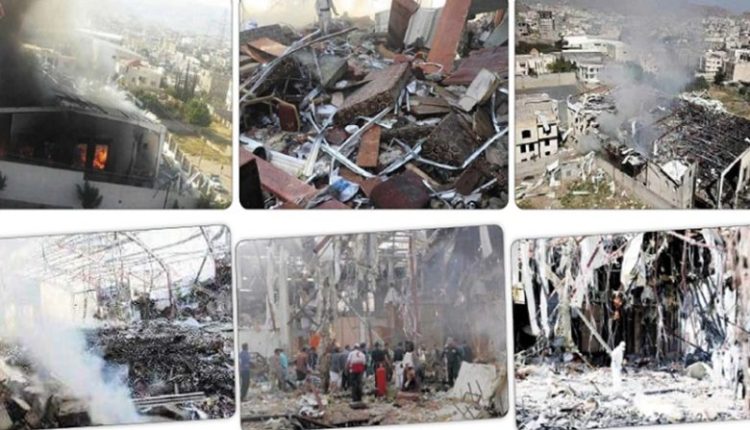Nine Years Since the Great Hall Massacre: A Memory of Pain and Resilience in the Face of U.S.-Saudi Crimes
Nine years have passed since the Great Hall massacre in Sana’a — and ten since the Sanban wedding massacre — yet the Yemeni collective memory continues to bleed from those open wounds. The hearts of the bereaved still carry the echoes of that dark day when American-made missiles thundered above the heads of innocent civilians.
These two atrocities were not mere incidents in the chronicle of aggression; they were blood-stained milestones of a brutality beyond description — an indelible mark of shame on the face of the U.S.-Saudi-Emirati coalition that turned weddings into funerals and mourning halls into human infernos, in scenes that defied every law, value, and human norm.
The Sanban Wedding… When Joy Was Slaughtered by Crime
On October 9, 2015, the village of Sanban in Dhamar province was preparing for a night of joyful celebration — the wedding of two young villagers.
Moments later, Saudi-American warplanes intruded into that happiness with precision-guided missiles, erasing joy in an instant and sowing grief in every home.
More than fifty civilians — most of them women and children — were killed, and dozens wounded. The ground was soaked with the blood of innocents in one of the most horrific crimes that revealed a moral and humanitarian collapse unprecedented in the region’s modern history.
The village turned into one vast funeral; the songs of celebration became screams of agony. The crime made it clear: the aggression did not target fighters, but life itself. The U.S.-Saudi hatred recognized neither sanctity nor humanity.
The Great Hall Massacre… When Sana’a Burned with Its Own Tears
Just one year after Sanban, on October 8, 2016, the U.S.-Saudi-Emirati coalition chose another target — a packed funeral hall.
Within seconds, missiles rained down on thousands of mourners gathered at the Great Hall in Sana’a to pay condolences for the death of Sheikh Ali al-Ruwaishan. The hall turned into a blazing inferno of fire and smoke.
More than 1,000 people were killed or injured, among them the Mayor of Sana’a, Abdul Qader Hilal, and several national figures. Many were burned alive; others were dismembered. The massacre shocked the world — even its most complicit observers — and exposed the true face of the coalition: a campaign that bombed both weddings and funerals, sending one unmistakable message — no civilian is safe, and no Yemeni blood is sacred.
A Full-Fledged War Crime — and a Belated Admission
Images from the Great Hall were enough to expose the coalition before the world.
International condemnations poured in. The United Nations and dozens of human rights organizations described the attack as a “full-fledged war crime.”
Under immense pressure, the coalition’s command admitted to the massacre, blaming a so-called “technical error” — a justification that deepened rather than softened the crime.
Human Rights Watch confirmed that the bombs used were U.S.-made GBU-12 Paveway II laser-guided munitions, proving that Washington was a direct legal and moral accomplice — especially since the airstrike was coordinated from U.S. and British command rooms.
Justice Denied, Perpetrators Protected
Despite the clarity of the crime and the admission of guilt, justice remains absent — for the very system of “international justice” is held hostage by the perpetrators themselves.
The United States and Britain, the heads of the aggression, hold veto power in the U.N. Security Council and dominate international judicial mechanisms — making accountability within that framework a political farce.
Nonetheless, Yemeni legal experts affirm that such crimes do not expire, and that prosecution may still be pursued through European courts that apply universal jurisdiction, even if obstructed by political immunity granted to senior war criminals.
A Memory That Never Dies, A People That Never Forget
The Great Hall and Sanban massacres remain deeply engraved in the Yemeni consciousness — told by mothers to their children as stories of blood and defiance, recalled every year by media and activists to prevent pain from being buried under silence.
This memory is not for mourning alone; it is a call to awareness — a reminder that Yemeni blood will not be erased and that the aggressors were wrong to believe their crimes would be forgotten.
The Yemenis write their memory in blood — and preserve it with loyalty.
From Pain to Power: A New Yemen Rises from the Ashes
Today, eleven years after the blessed September 21 Revolution, Yemen stands tall despite the scars.
Its political decision is liberated from U.S.-Saudi tutelage. The nation has transformed from victim to active force within the Axis of Resistance, confronting the U.S. and “Israel” from a position of strength, not weakness — charting a path of sovereignty paved with the blood of its martyrs.
The Great Hall m

